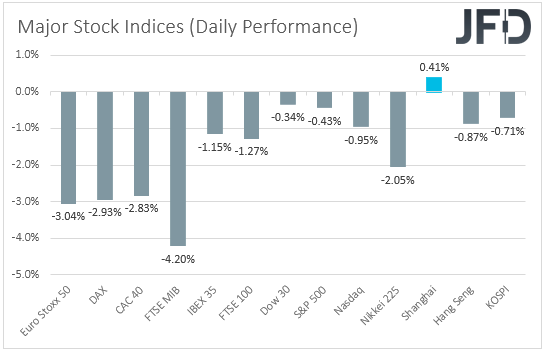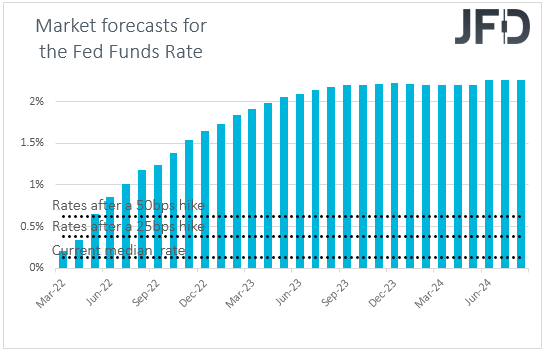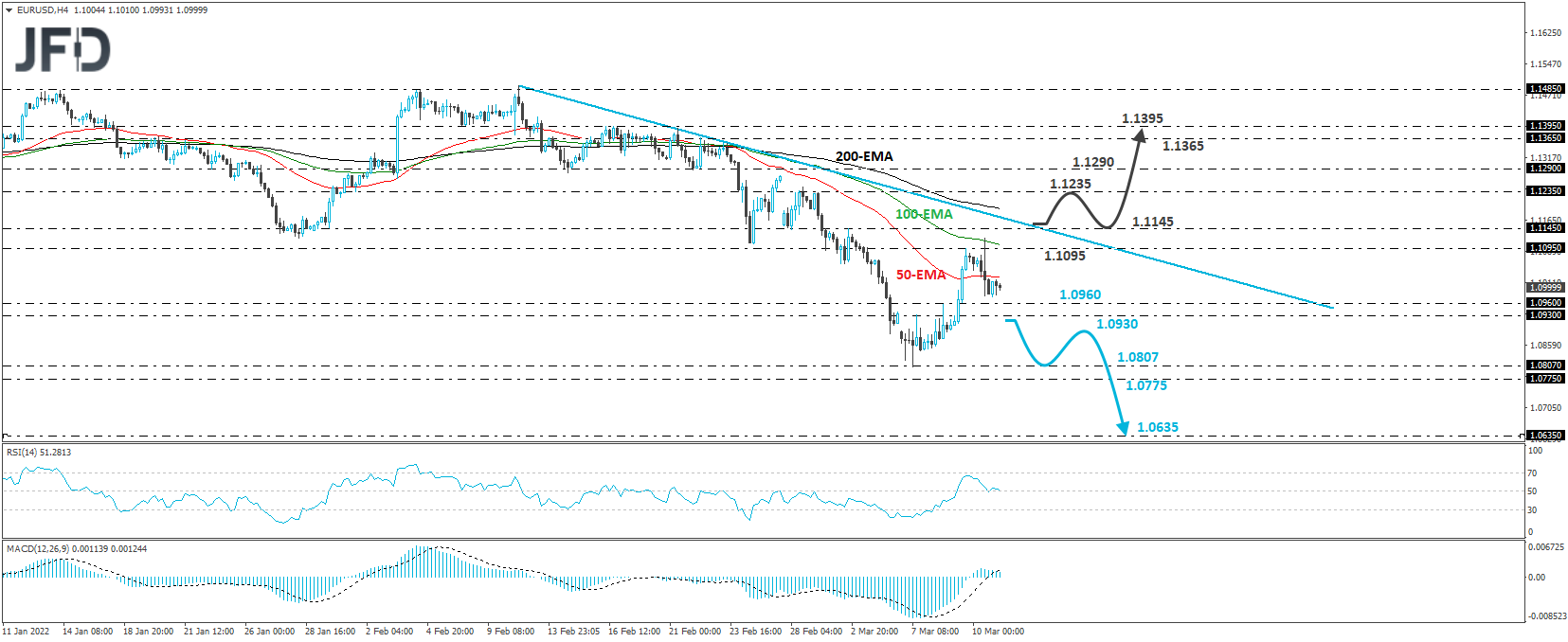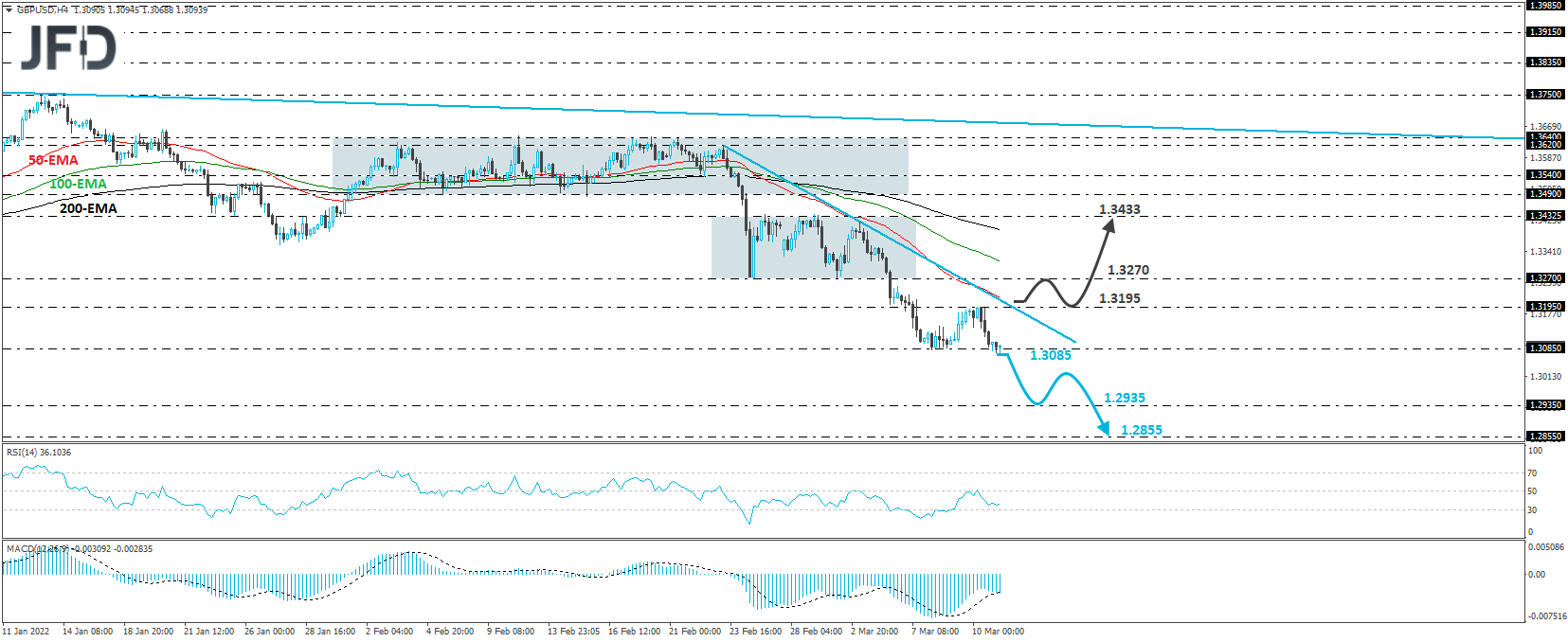The main events on yesterday’s agenda were the ECB decision and the US CPIs for February, with both of them prompting market participants to bring forth their bets with regards to rate increases by the ECB and the Fed. The ECB announced it would end its APP sooner, without signaling any delay in a rate increase, while the US CPIs kept accelerating, with the underlying rate beating estimates notably.
ECB to End App Sooner, Fed Could Hike Faster on Rising Inflation
The US dollar traded mixed against the other major currencies on Thursday and during the Asian session Friday. It gained against GBP, EUR, JPY, and CHF, in that order, while it slightly underperformed versus CAD, AUD, and NZD.

The strengthening of the US dollar against the pound and the euro suggests that sentiment was dented again by developments surrounding the crisis in Ukraine. However, the failure of the safe-havens yen and franc to stay supported, and the strengthening of the risk-linked Loonie, Aussie and Kiwi, point otherwise. Thus, to clear things up, we prefer to turn our gaze to the equity world.
We see that major EU and US indices traded in the red, with Asia following suit. The only exception among the indices under our radar was China’s Shanghai Composite, which gained 0.41%. This may have been the result of the negotiations between Russia and Ukraine falling apart, as well as a more hawkish than expected ECB and accelerating US inflation.
The ECB kept all three of its main interest rates untouched, as was widely anticipated, but decided to end its Asset Purchase Program in Q3, without hinting that any interest-rate hikes will be delayed due to the geopolitical tensions. President Lagarde said that the risks to the economic outlook had increased substantially, but inflation could also be considerably higher than forecast.
Combined with a considerable upside revision to the inflation forecast for this year, this suggests that most policymakers view the risk of high inflation outweighing concerns on how geopolitics could affect economic growth. This increased speculation for higher rates later this year, with market participants now pricing in nearly 50bps by the end of the year.
The euro initially spiked higher due to that. Still, it was quick to give back those gains and trade even lower against its US counterpart, perhaps due to the fallout in talks between Russia and Ukraine, but also due to further acceleration in US inflation.
Remember that when testifying before Congress, Fed Chair Powell said that he is ready to use larger or more frequent rate hikes if inflation doesn’t slow, and yesterday’s data may have added to speculation on that front. Indeed, according to the yields of the Fed Funds futures, market participants are now pricing in slightly more than six quarter-point rate increases by the end of this year.
EUR/USD – Technical Outlook
EUR/USD spiked higher after the ECB decision but found resistance slightly above 1.1095 and pulled back again. The retreat confirms our view that as long as the rate remains below the downside line drawn from the high of Feb. 10, the bears have decent chances of jumping back into action. That’s why we will maintain the view that the short-term outlook is still negative.
However, to get confident on more declines, we would like to see an apparent dip below 1.0930, marked by the inside swing high on Mar. 7. This could pave the way towards the low of that day, at 1.0807, or the 1.0775 territory, marked by the low of May 14, 2020. If the bears are unwilling to stop there this time around, we are likely to see extensions towards the low of Mar. 22, 2020, at 1.0635.
On the upside, we would like to see a clear break above 1.1145 before abandoning the bearish case. This could signal the break above the aforementioned downside line and may initially pave the way towards the 1.1235 zone, marked by the peak of Mar. 1.
The next resistance to consider if that doesn’t hold may be at around 1.1290, a territory that provided support on February 14th and 22nd, the break of which could extend the advance towards the 1.1365 barrier, marked by the peak of Feb. 22.

GBP/USD - Technical Outlook
GBP/USD traded lower yesterday after hitting support at 1.3195 yesterday. The rate is testing the 1.3085 barrier at the time of writing, where a dip would confirm a forthcoming lower low. This, combined with the fact that Cable continues to trade below the downside resistance line drawn from the high of Feb. 23, keeps the short-term bias to the downside.
A potential break below 1.3085 could encourage the bears to dive towards the low of Nov. 5, 2020, at 1.2933, and if they are not willing to stop there either, we may see them pushing towards the low of Nov. 2 that year, at 1.2855.
On the upside, we would like to see a decisive break above 1.3195 before we start examining the case of a significant recovery. This could confirm a forthcoming higher high on the 4-hour chart and the break above the downside line drawn from the high of Feb. 23.
The next stop may be at 1.3270. If it doesn’t hold, could set the stage for extensions towards the 1.3433 zone. That territory acted as a strong resistance on Feb. 23 and Mar. 3.
As For Today’s Events
During the early European session, we already got the UK monthly GDP for January, as well as the industrial production and manufacturing production rates for the month, all of which decently beat estimates.
However, in our view, this is far from enhancing the case for a double hike at the BoE’s upcoming gathering, and this is evident by the fact that the pound did not respond at the time of the release. With Russia’s invasion of Ukraine raising concerns over the global economic performance, we see a 25 bps hike as the best-case scenario.
Later in the day, Canada’s employment report for February is scheduled to be released. The unemployment rate is expected to have slid to 6.2% from 6.5%, while the employment change is forecast to show that the economy has added back 160.0k jobs after losing 200.1k in January.
In our view, this will be a decent report, which, following the better-than-expected GDP for Q4 last week, as well as the upside surprise in the Canadian CPIs for January, could increase speculation over a rate hike by the BoC at its upcoming gathering.
Let’s not forget that, although officials stood pat last time, they noted that they expect rates to increase and that the overall economic slack is now absorbed.
